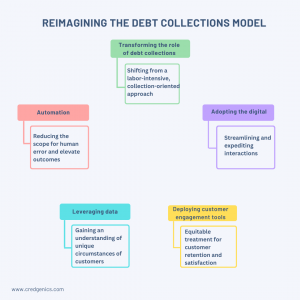Debt collection is essential to maintain the financial health of any lending business. Considering the dynamism and complexity of various aspects involved, it can be a challenging and sensitive process. The effectiveness of debt collections depends on several factors, including industry developments, risk involved, nature of debt, and the debtor’s receptiveness.
Financial institutions can prompt customers to initiate contact on their own by shifting from resource-heavy, outbound methods aimed at locating paying customers to a proactive system in which banks suggest pre-approved solutions and personalized communication. This reimagined strategy has the potential to offer highly personalized and efficient customer service on a large scale, in addition to helping lenders streamline the collection of debt.
Key areas for banks to reimagine the debt collections model
Transforming the role of collections
Reconfiguring the collections approach, transitioning from a human effort-intensive methodology to an intelligent and proactive system, can increase operational efficiency and enhance the motivation levels of the workforce. Notably, the implementation of such a model positions the banks for higher resilience during uncertain periods. It also entails a fundamental transformation of the role associated with payment collections, evolving from that of a frontline debt collector or administrator to that of a financial advisor.
By engaging their workforce effectively and providing training that imparts greater empathy and compassion towards customers, banks can significantly enhance their ability to communicate with customers facing financial difficulties. This improved communication is of paramount importance for the success of a debt collections campaign.
The adoption of a modified repayment model also gives bank employees a strong sense of purpose. They see their work as a means of offering the right solutions to customers during challenging times. This heightened sense of purpose holds significant appeal for attracting new talent and elevating job satisfaction among those already employed in this field.
Automating processes
In the years to come, financial institutions will face higher rigour in regulatory scrutiny to ensure equitable and fair treatment of customers. To navigate this aspect, banks have begun to harness the power of process automation and predictive analytics, thereby eliminating the potential for human bias or arbitrary judgments in decision-making. At the same time, it becomes crucial to put in place extensive testing programs that examine the various approaches to the entire process of collection of debt and their effect on customer outcomes.
In a broader context, it is imperative for banks to invest in the automation and optimization of their back-end processes. Neglecting this transformation could expose them to challenges related to accounting reconciliation and amortization, ultimately affecting their balance sheets. A critical time frame of 30 to 60 days typically exists for banks to process loan modifications; any delay in this period could trigger significant accounting complexities on a large scale.
The integration of self-service capabilities, for instance, enables customers to educate themselves about available options before initiating conversations with their banks. This approach tends to work effectively for relatively straightforward tasks, such as rescheduling payments. However, it’s worth noting that it doesn’t eliminate the necessity for specialized expertise, particularly in intricate scenarios involving cross-product holdings.
Adopting the digital
Banks have a responsibility to support customers in time of need. The incorporation of a digital layer on this support system can significantly enhance their ability to assist a wide range of customers in a swift and efficient manner. It’s crucial for banks to demonstrate a deeper understanding of their customers’ specific needs and circumstances across all communication channels. By harnessing the capabilities of their digital platforms, banks can offer customers timely notifications regarding debt collections options. This proactive approach provides customers with greater clarity and insight into the details of the recovery mechanism, ensuring they comprehend the terms and implications of their participation.
In addition, the success of a collections campaign hinges on banks harnessing virtual agents and chatbots to address routine payment inquiries. Consequently, when customers contact their bank, the interaction becomes more streamlined and expedient.
Embracing a more extensive digital framework empowers banks to initiate contact with customers at an earlier stage, thus contributing to the enhancement of customers’ financial well-being and fostering greater long-term value for all parties involved.
Using data to understand customers
Financial institutions that harness the potential of data to gain a comprehensive understanding of each customer’s unique circumstances can leverage this knowledge to create a tailored repertoire of pre-approved debt solutions. There is a greater need for banks to get a higher degree of certainty regarding customer defaults or necessary loan modifications. To prepare adequately, banks should broaden their data sources, encompassing legal and employment records, credit histories, and financial data. This expansion, combined with the integration of predictive and behavioral analytics, empowers banks to gain deeper insights into their customers’ financial positions.
While banks already possess a substantial volume of customer data, the key lies in utilizing and applying this information more effectively. This approach not only enhances the model of collection of debt by delivering a more gratifying and personalized customer experience but also augments the likelihood of successful debt recovery. Banks now have the opportunity to significantly enhance their data intelligence, allowing them to tailor the solutions they offer in the months and years ahead.
Deployment of customer engagement models
By committing to a proactive approach that prioritizes personalized and equitable treatment, banks hold the potential to enhance customer retention and bolster overall satisfaction.
As we approach periods with heightened possibilities of defaults, banks gain greater clarity on which customers may require additional support. In practical terms, this translates into an approach that is compassionate and tailored, aimed at understanding the unique personal situations of customers and the ways in which financial institutions can provide assistance. Banks must incorporate predictive analytics to gauge probable customer behavior and segment their customer base accordingly. This approach gives banks a deeper understanding of real-time customer dynamics in the market, enabling them to confidently pre-approve customized treatment strategies where warranted.
Banks bear a responsibility to assist their customers, and the implementation of a holistic collections model empowers them to manage their customer relationships with greater compassion. Failure to prepare adequately for the anticipated surge in defaults in the coming months carries the risk of regulatory penalties, substantial cost increases, and a threat to the institution’s reputation.

Summarizing
In conclusion, the landscape of debt collections is undergoing a significant transformation in response to the evolving needs and expectations of both financial institutions and their customers. This shift represents a commitment to a more empathetic, personalized, and data-driven approach that fosters customer trust, satisfaction, and financial well-being. Banks have a vital role in supporting customers during challenging times, and that role extends far beyond traditional practices of debt collections.
The financial institutions that embrace these changes and make strategic investments in technology, data analytics, and workforce development will be better equipped to navigate the challenges ahead. Their ability to proactively anticipate customer needs, provide tailored solutions, and engage with compassion will not only ensure regulatory compliance but also foster long-term customer loyalty.
Failure to embrace this evolution runs the risk of regulatory penalties, higher operating costs, and reputational damage in addition to increased operational costs. The way forward is obvious: banks must take advantage of the chance to reimagine how they interact with their customers, not just for their own success but also for the overall financial security of all parties. For those willing to embrace it, the future of debt collection will be more compassionate and customer-focused.
If you are looking to transform your debt collections strategy with the power of digital and data-powered insights, reach out to us to request an exploratory session at sales@credgenics.com or visit us at www.credgenics.com
FAQs:
Q.1 What are the key components of an effective system for the collection of debt?
An effective debt collections system involves a combination of strategies, including early communication with debtors, maintaining detailed records, customizing the approach, offering payment plans or settlements, and, if necessary, taking legal action. It also requires compliance with debt collections laws and an empathetic approach to customer interactions.
Q.2 How can a business determine which debt collection approach is most suitable for their needs?
The choice of debt collections approach depends on several factors, including the nature of the debt, the debtor’s willingness to cooperate, and the risk involved. Analyzing the debtor’s financial situation and age of the debt, as well as considering legal options, helps determine the best approach.
Q.3 What role does data play in an effective debt collection system?
Data is essential for understanding customer behavior and predicting financial situations. It allows banks to create personalized debt solutions, anticipate defaults, and provide tailored communication. Utilizing data effectively enhances the likelihood of successful debt recovery.
Q.4 Can automation and technology enhance the effectiveness of debt collection?
Yes, automation and technology are pivotal in modern debt collection systems. They help in streamlining processes, eliminating human bias, and improving operational efficiency. By leveraging digital channels, banks can offer customers timely notifications about debt modification options, enhancing the customer experience.
Q.5 How can banks manage the transition to an inbound debt collections model effectively?
Transitioning to an inbound model requires a fundamental transformation of the collections approach. This includes training the workforce to be more empathetic and compassionate, integrating automation, and making better use of data sources. Banks should also invest in self-service capabilities and virtual agents to streamline customer interactions, leading to a more compassionate and efficient approach to debt management.





